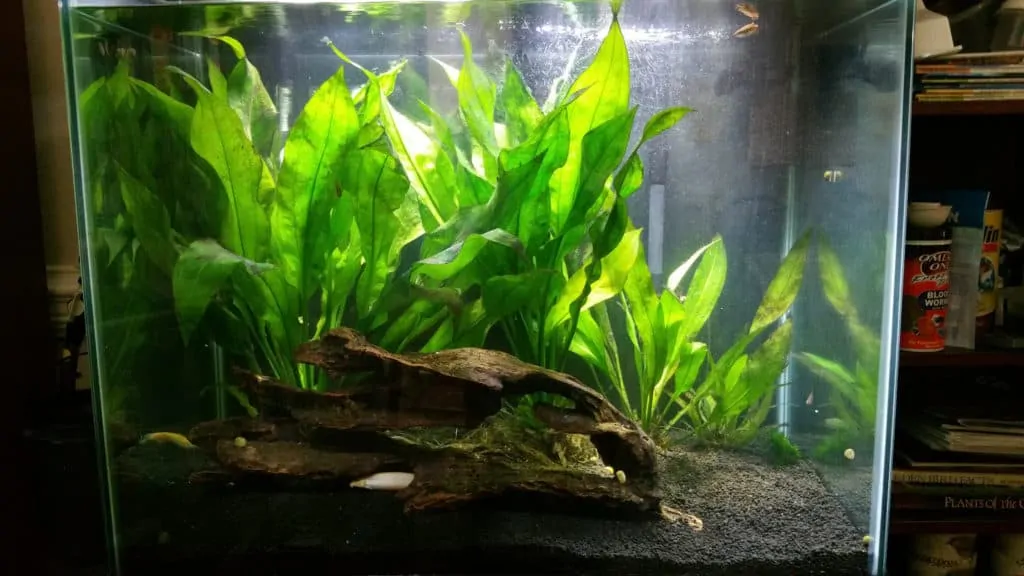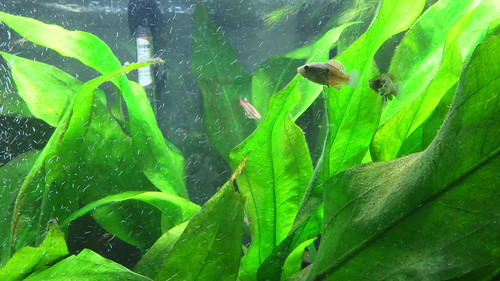Amazon sword is a common name for multiple plant species in the Echinodorus genus, like Echinodorus bleheri and Echinodorus amazonicus. These lush, green rosette plants are among the most popular aquarium plants because they are very easy to grow, even for beginners.
Keep reading for everything you need to know about Amazon sword care and growing Amazon sword in your aquarium!
| Minimum recommended aquarium size | 30 gal/113.5L |
| Care level | Easy |
| Placement | Background |
| Temperature | 71.5-83 °F/22-28 °C |
| pH | 6.5-7.5 |
Planting Amazon sword
Because of the size this plant can reach (up to 20 inch/50cm or even taller), Amazon sword is best used as a background plant in larger aquariums: the large, green leaves make it a great focal point.
To plant your Amazon sword, just stick it in the substrate (make sure not to bury the crown!) and make sure the roots are covered to prevent it from floating back up. Because these plants are such quick growers, they will really appreciate some extra nutrients in the form of root tabs. You can place these near the roots while planting.
Amazon sword care & tankmates
- After your Amazon sword has been planted, there isn’t much else that needs to be done. This easy plant doesn’t require extra Co2, although it will definitely be appreciated. Very strong lighting is not necessary either: even under low to medium light, Amazon swords should do quite well.
- New growth should appear quickly. Be sure to keep an eye on this and prune where necessary to prevent the swords from blocking out too much light and becoming too large. Remove any yellowing, dead or dying leaves; these are lost and will not repair themselves.
- This species will send out runners and you can propagate it by separating these from the main plant and replanting them. They can also be sold or given away. If you allow your Amazon sword to grow (partially) emersed, it might produce flower stalks with small white flowers and possibly some runners attached to them.
- When it comes to tankmates, Amazon sword is not too picky. It can be combined with most fish and invertebrates besides large cichlids, goldfish and Plecostomus catfish, which will cause trouble for almost all aquarium plants by uprooting and eating them. A hardier plant like Java fern might be a better idea if you keep any of these fish.
Problems with Amazon sword
Although Amazon swords are relatively easy to grow, there are still some problems that might be encountered. Luckily these are all relatively easy to solve.
- Yellow leaves. Yellowing leaves are a tell-tale sign of iron deficiency. As discussed above, these plants will really appreciate some extra root tabs so be sure to add some of these if you haven’t already. If this alone doesn’t seem to be enough, which might happen especially if you keep your tank densely planted, you can also supplement with a liquid plant fertilizer or consider working with added Co2.
- Algae growth on leaves. Algae growing on any plant can be very annoying but is especially bothersome with these large-leaved species. Be sure to gently wipe off any algae regularly. If things don’t stabilize after a while, this is a sign that there might be some kind of nutrient imbalance going on in your tank causing algae to take over. Until this is fixed, the algae will keep returning.
Buying Amazon sword
Finding Amazon sword plants to grow in your own aquarium shouldn’t be too much of a challenge. Keep in mind that, as discussed earlier, “Amazon sword” is a common name used for multiple species in the genus Echinodorus. These plants might also be labeled incorrectly. Going for Echinodorus bleheri or Echinodorus amazonicus is a relatively good guarantee if you want to get the correct plant.
You should be able to find Amazon swords in most aquarium stores. You can also easily buy them online: just look for a seller with good reviews, such as this one.
If you have any more questions about Amazon sword or if you want to share your own experiences with this plant, don’t hesitate to leave a comment below. Happy fishkeeping!
Cover photo: 20150523_132759 by mobile_gnome.




guess I should of proof read before I sent My amazon sword has plants growing on its leaves I thought it was algae at first but noticed today that there are leaves growing with the roots have you ever seen this?
I haven’t seen that on an Amazon sword plant, no, but I’m familiar with Java fern doing it. I mean, it can’t be a bad thing and plants do tend to do odd stuff so I’d just sit back and see what happens! 🙂
I know these can’t be attached to the surface of driftwood, but could I put them in a small soil filled crevice *in* the rock or driftwood?
Thanks
They grow quite a large root structure so I would think very difficult at best.
Gosh, I totally missed Mason’s comment! Embarrassing. Glad you caught it. I agree, these things have massive root systems. I do think they’re very hardy so they might find a way, but it’s not the ideal way to grow them 🙂
I know these can’t be attached to driftwood, but could I put them in a small soil filled crevice *in* the rock or driftwood?
Thanks
Hi Mari,
Love your site! I’m just starting up my aquarium and am preferentially seeking out articles on your webpage. Keep up the tremendous work.
I was not aware that the Plecostomus loves to uproot plants. I was set on buying one.
Hi! So glad to hear the site is helpful to you, if you have any specific questions let me know.
As for the Plecostomus, if you were planning on getting a bristlenose Pleco or other small species it should be fine. Large Plecos (common, sailfin) are the real problem there.
Good luck!